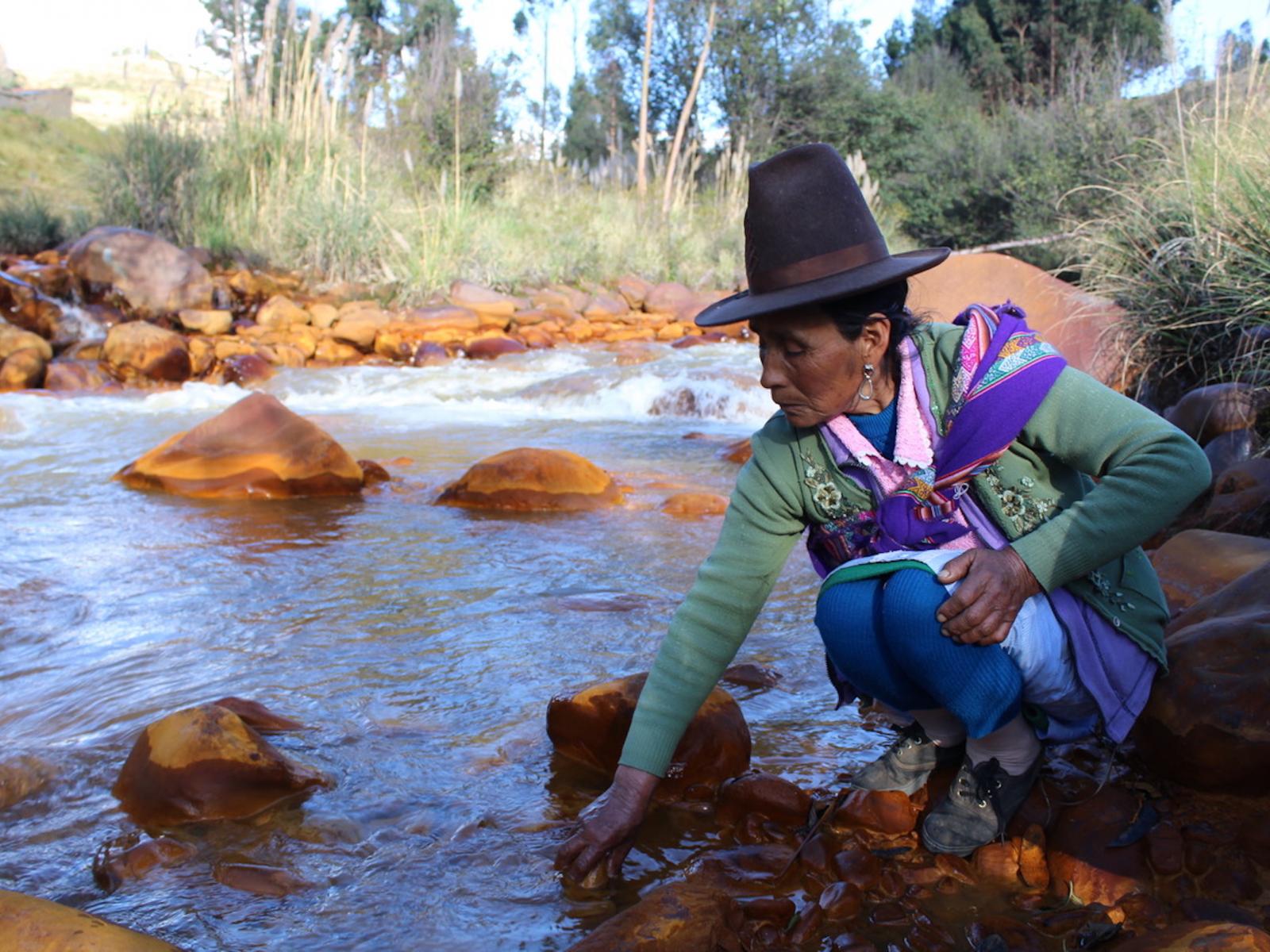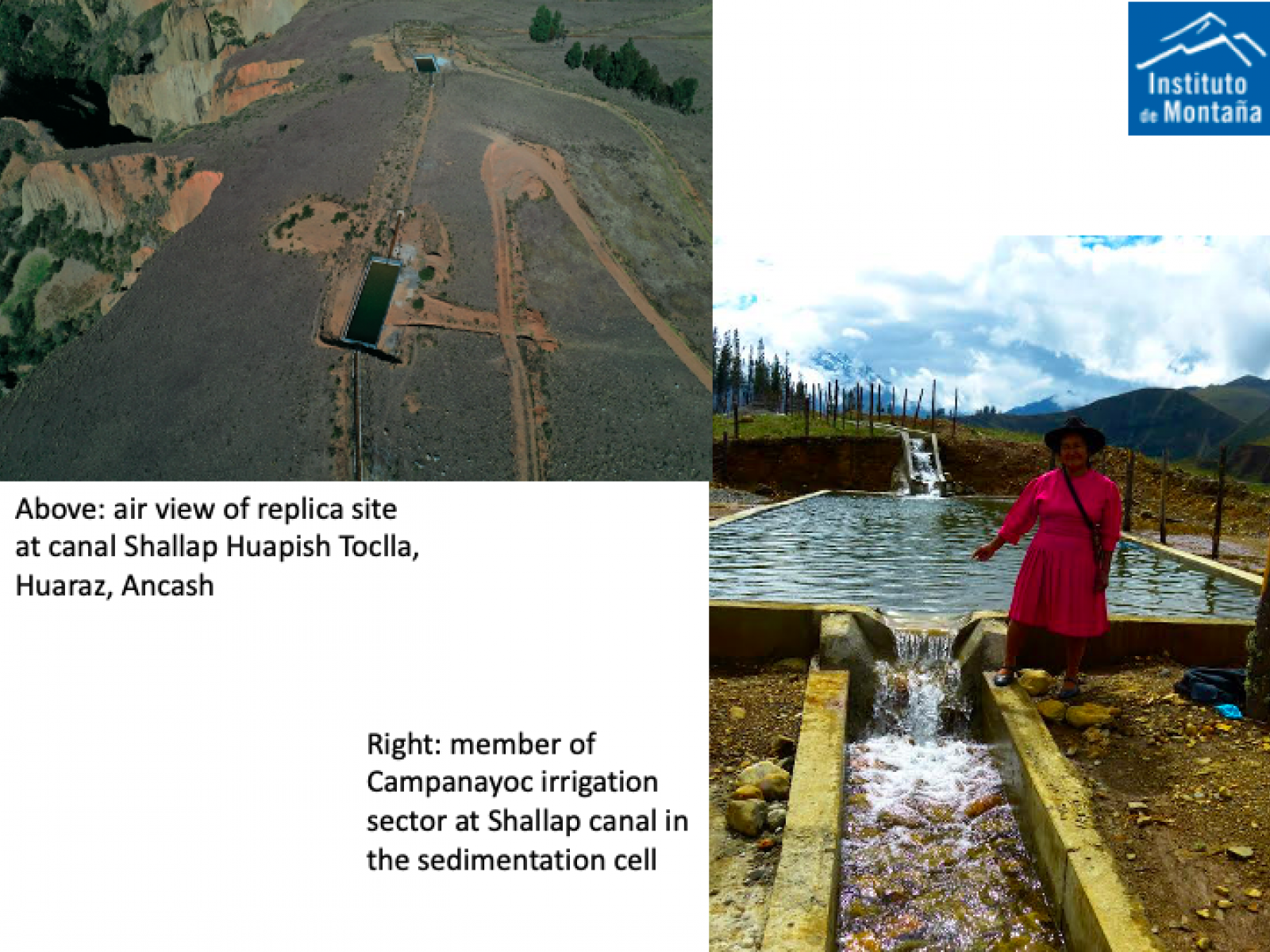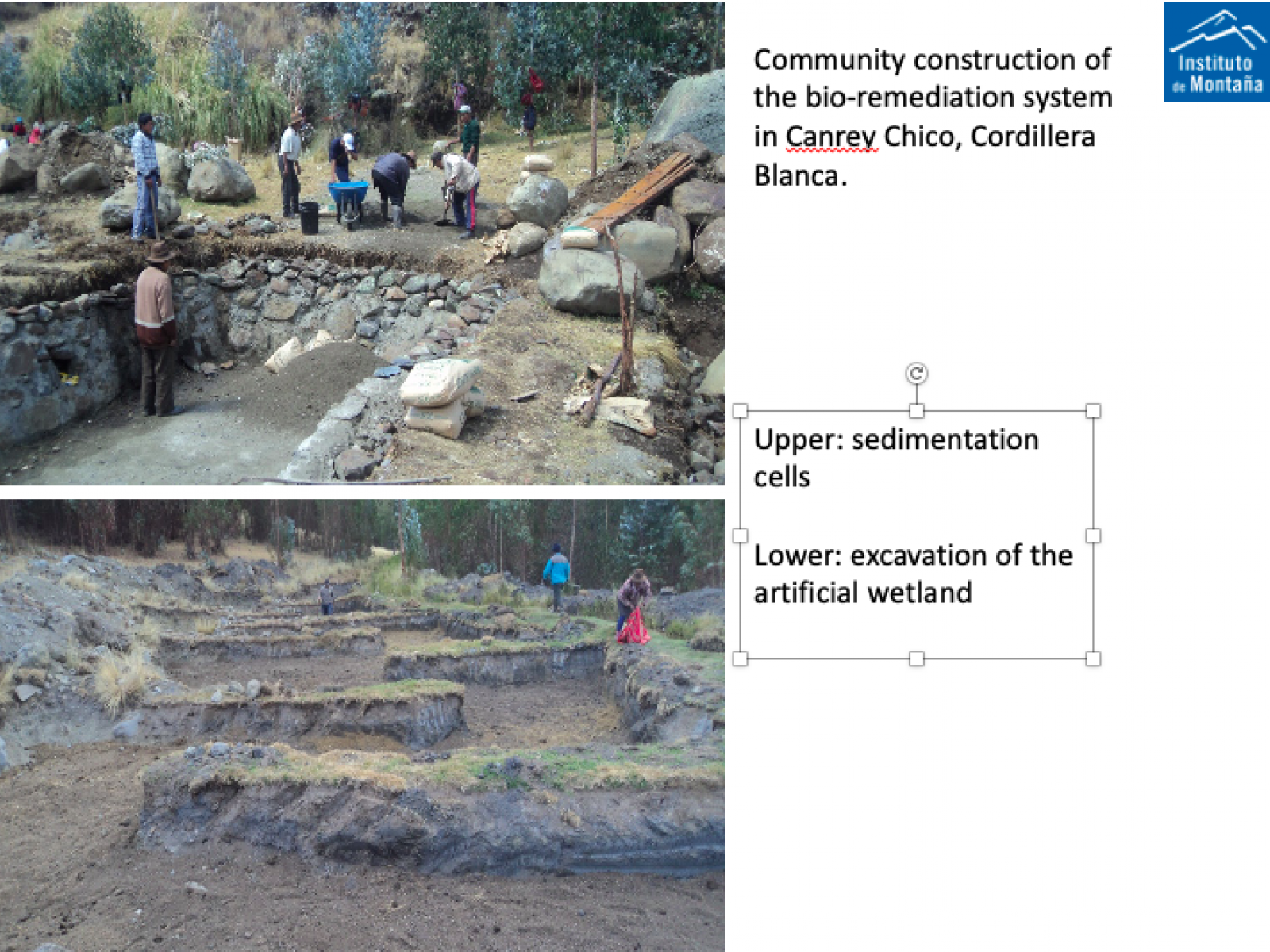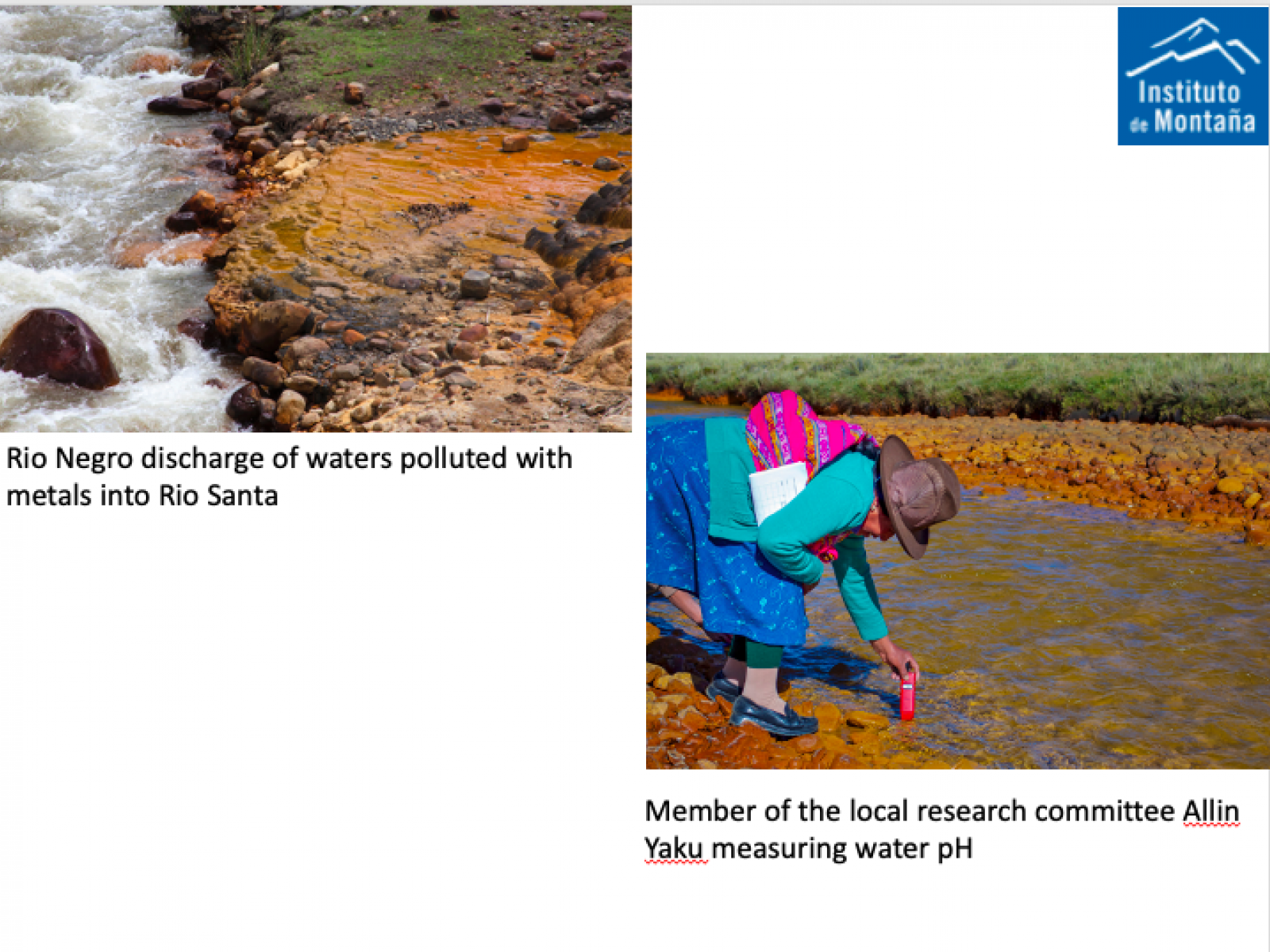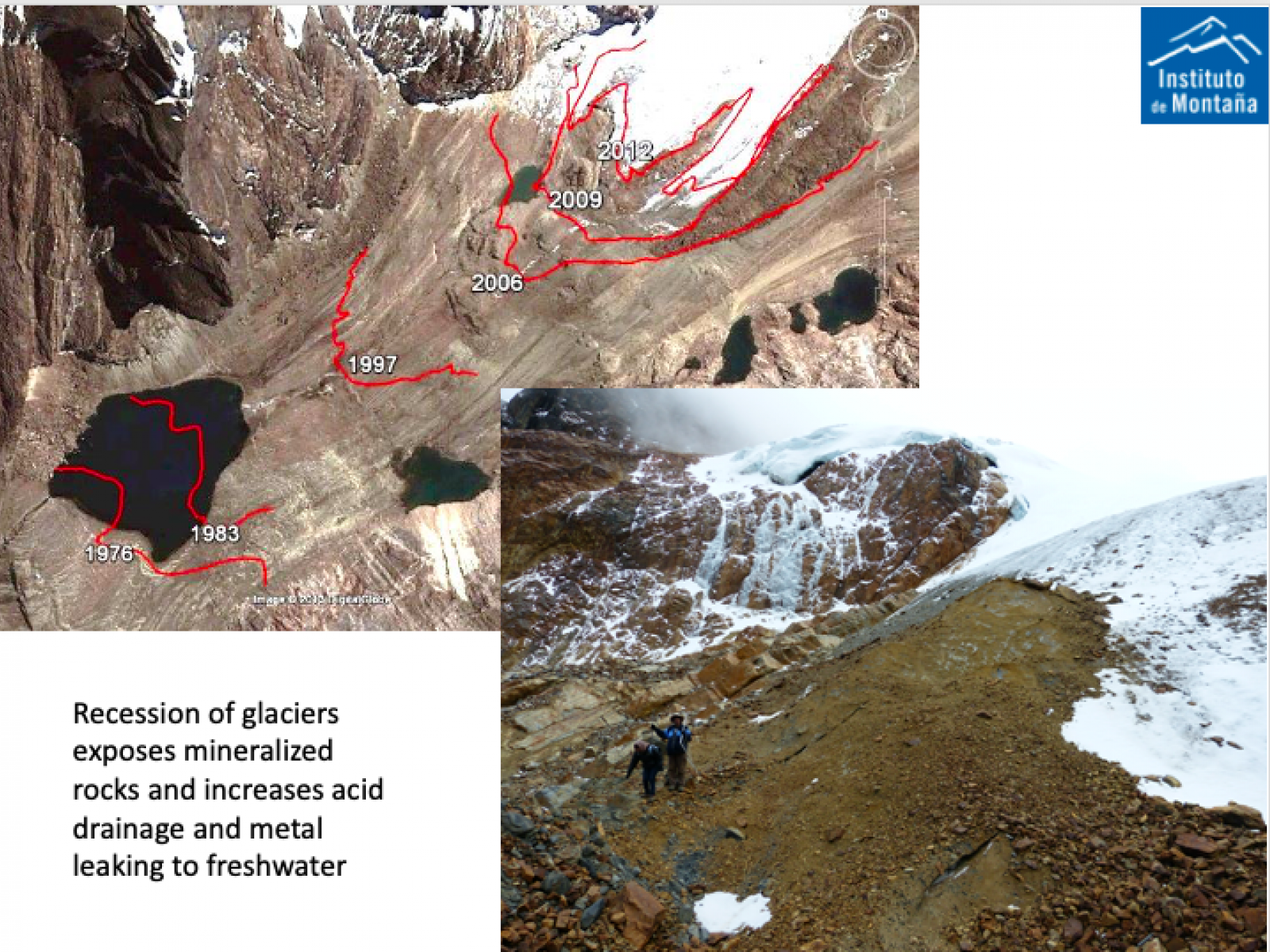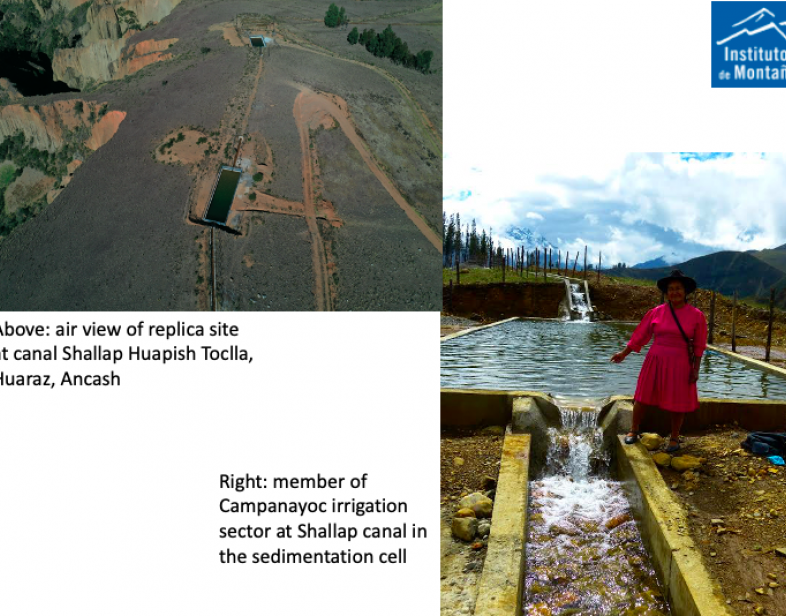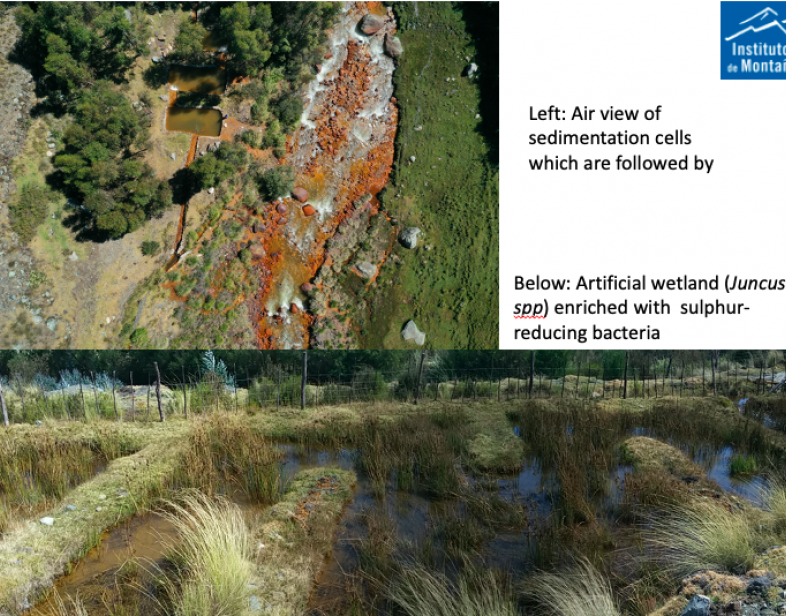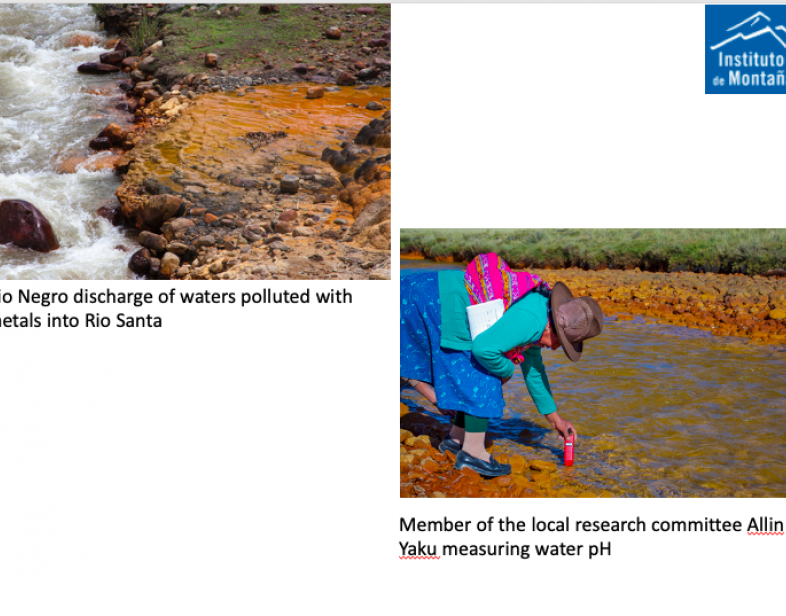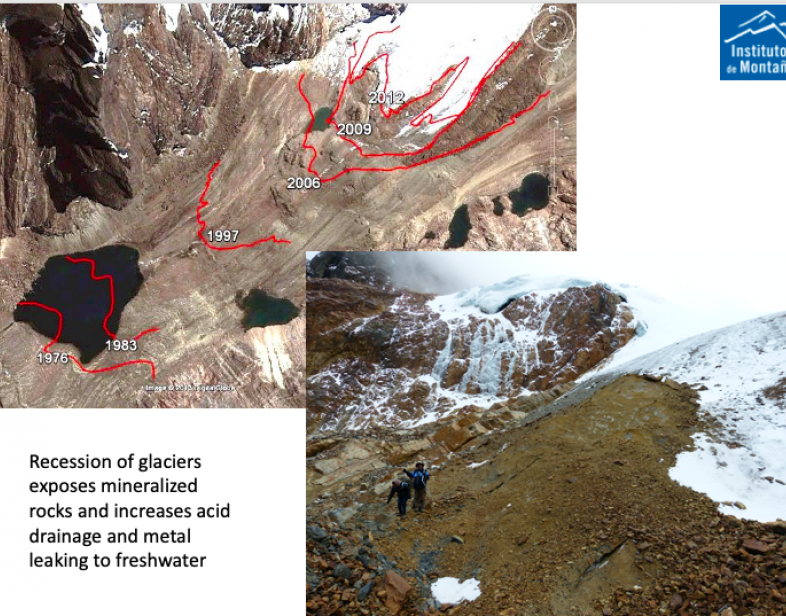An Overview Of Our Solution
Problem: There are 8,791 mine tailing sites identified in highland Peru that contaminate freshwater sources with acid rock drainage (ARD) and metals. Recession of 18 glacier ranges as a result of climate change is worsening ARD. Pollution with metals affects irrigation systems, crops and human health. Mountain communities have low trust on information about environmental problems coming from outside sources.
Solution: We used a Participatory Action Research approach, a structured process that affirms local knowledge and the capacities required to engage external experts as colleagues. This approach yields information that is usable and trusted by communities. The technical solution designed by local researchers was a low-cost artificial sedimentation and artificial wetlands that quickly improves pH reducing the level of metals in water.
- Population Impacted: 1,200
- Continent: South America
背景分析
We are operating in high mountain areas of Peru. There are 7,657 mountain communities with territories overlapping with industrial mining concessions (18.9 million hectares). The land is impacted by over 8,000 dispersed, small-scale, old tailing deposits. These tailings generate acid mine drainage (AMD) that leaks metals into de water, impacting farming and health. There are about 200 active social conflicts at any given moment in Peru, 66% catalogued as environmental and most linked to nearby mines. This problem is being compounded by recession of glaciers (loss of 45% between 1970 and 2019) that produce AMD that leaks metals. Communities where the bioremediation was tested and replicated are located in the Cordillera Blanca, Ancash region. It is important to mention that this is the highest tropical mountain range in the world and that its natural and cultural values are protected by the Huascarán National Park. AMD and metals affected irrigation systems and crop production to the point they had to be abandoned. Communities are distrustful of environmental information coming from outsiders. Our behavioral approach addressed this challenge.
描述您希望目标受众采用的技术解决方案。
The solution was devised with intense involvement of the communities. As a result of the social and behavioral approach followed, local indigenous researchers trained themselves on key aspects of water quality, collected information, discussed it with their communities and engaged with scientists to design a solution. The solution was a low-cost bio-remediation system using simple techniques to sediment water and capture metals in artificial wetlands. The first system was designed to clean water to irrigate up to 173 hectares. The system consists of three sedimentation cells (each 4.5 m x 9.5 m x 1.2 m); water then flows into an artificial wetland of native Juncus spp. The wetland uses local materials: one layer of coarse gravel, followed by sand, and then organic matter, native Juncus spp and sulphate-reducing bacteria grown and provided by the local university. The level of metals is reduced to within ranges approved for agricultural use.
描述你的行为干预。
Our behavioral approach is “Participatory Action Research” (PAR). This method posits that sustainable solutions require information that is usable and trusted for collective action in a community. The community first identified that they had a problem with water contaminated that was affecting their pastures to the point they had to abandon their main irrigation system. The community contacted us to provide a solution. Our approach was to train local researchers so that they themselves assessed technical options and recommended the solution to their community. A volunteer local research group, self-named “Beautiful Water and Pastures” (Quechua “Allin Pastu Allin Yaku ) trained itself on principles of water quality, learned use of water test kits, mapped the quality of water in main rivers of their community, established non-hierarchical dialogue with external experts and identified best solutions. At each step, the Allin Yaku group engaged their community reporting their learning, sharing data produced by them or by external sources and provided leadership to the entire process. This locally-driven process led the community to decide to invest their own labor and resources to build the solution and lobby their local government to mobilize complementary resources (food for work, machinery, tools, materials). The result was the building of artificial bioremediation wetlands that are owned and managed by the communities.
使用的行为杠杆
如需要,请更详细地解释你是如何使用杠杆的。
1. Emotional appeals: the PAR process builds sense of pride on local knowledge. External facilitators deploy behavior that places them in the position of “students”. Their behavior reinforces the value of local knowledge. This is done to establish collegial relations between local researchers and external experts. 2. Information: Local researchers work on problems identified by their community. They learn how to convert the problem into a research question, to collect and analyze information, to engage external sources providing a range of potential technical solutions, select best options and finally share the information with their community to take action. 3. Social influence: mostly consists in the creation of opportunities for local researchers to display their own solutions in academic and governmental settings and also with other communities facing similar problems. As a result of this three-pronged strategy, the “persona” of a proud local researcher is interiorized.
描述项目的实施。
1. The community worked on a problem that was clearly owned by them: loss of health and valuable irrigation land because of contaminated water.
2. The community delegated work on the problem to a group of local researchers (Allin Yaku committee). Facilitators from Instituto de Montaña fostered a process of reflection-action-reflection with this group and the broader community.
3. Instituto de Montaña facilitators cooperated with Allin Yaku to describe the problem with water more specifically and develop a research plan. This plan involved a set of steps (i) defining the concepts in their own cultural codes (e.g. “contaminated” or “clean” water); (ii) establishing the objectives and concrete results expected at the end of the research; (iii) planning activities in a time table; and (iv) defining roles and responsibilities of the research committee and the community.
4. The Allin Yaku team was trained on how to measure water quality parameters, they then assessed the status of water in 22 streams of their community, discussed results with experts and explored possible solutions including bioremediation with artificial wetlands.
5. Allin Yaku took stock of their learning and presented it to the community. As a result of collective analysis, the community decided to go for the bio-remediation solution.
6. The sixth step was to apply the results of their research: (i) discuss the detailed design with experts; (ii) identify and cost the materials required, (iii) propose a strategy to raise awareness and help from their local government; and (iv) construct the artificial wetland with collective labor and support of students and professors from the local university UNASAM.
7. The solution is adopted because local actors move from being passive observers of a problem to agents of solutions. Therefore, adoption of the solution and creation of enabling conditions results from a process conducted by and at the grassroots level, driven by their own existential goals and emotions
描述项目的主导者。谁在主导项目实施?
The local research committee, a group of eight men and women volunteers who are members of the community and are delegated by it provides the leadership for the entire process to find the specific solution to their water quality problem and then to implement it. The group meets regularly to conduct actions, discuss results, inform and engage the community in formal assemblies. The role of one facilitator working for our organization is to provide support to the group, reinforcing their ownership of the problem, the skills they need to conduct the process and seeking opportunities for the local research committee to celebrate milestones and results. While there is no planned connection to youth –because it is the community assembly that calls for volunteers– the process did incentivized action by local youth who participated in communicating results through local radio talks
分享参与解决方案开发和实施的关键合作伙伴。
Stakeholders included:
Other communities in the region for whom the solution identified may also work; more specifically two branches of Shallap canal in the neighboring province of Huaraz who have already replicated the solution.
Academics in local and national universities or government agencies who have information about potential technical solutions to the problem and willing to interact with the local research group. Universidad Nacional Santiago Antunez de Mayolo (students and teachers) provided volunteer advise to the build the artificial wetland, provided sulphate-reducing bacteria, monitored water quality impacts and published results. Universidad de San Marcos and Cayetano Heredia (both based in the capital city of Lima) are also conducting assessments of the solution so far implemented in two communities.
Key government agencies: The initiative was carried out in close coordination with the headquarters of the Huascaran National Park, as well as with the National Service of Natural Protected Areas (SERNANP)
Donors: The initiative is part of the “Punas-Agua” project implemented within the framework of the Collaborative Crop Research Program (CCRP) thanks to the support of the McKnight Foundation.
Local governments and NGOs that channel material resources to implement the solution. Other communities in the region for whom the solution identified may also work; more specifically two branches of Shallap canal in the neighboring province of Huaraz who have already replicated the solution with financial support from USAID. The community provided labor, a major cost of implementation.
谁采用了期望的行为,采取的程度如何? 解释一下你如何测量行为变化的。
The community as a whole adopted the solution. Behavioral change took place at the level of a) local researchers who perceived themselves as agents with capacity to find solutions and b) the community at large. The assessments were captured both qualitatively during the research cycle (11 workshops) and quantitatively through a survey to 62 members of the community at the end of the process. Qualitative narratives captured the existential dimension of change. These narratives supported nomination to a country-wide selection of best indigenous environmental practices conducted by the Ministry of Environment. The survey captured indicators to measure the degree of knowledge of the PAR process and of the solution. For example: 98% had general awareness of the PAR process; 17 % could not identify any of the streams assessed while 82.3% could describe from 1 to 6 places; 56% expressed trust in the effectiveness of the solution adopted.
项目是如何影响水污染的?请详细说明并包括相关的测量方法。
A holistic indicator of the positive impact in water pollution was the recovery for agriculture of 40 hectares irrigated by the Chonta canal as a direct result of the bio-remediation solution.
Example of changes in water quality parameters were: (i) water pH improved from 3,4 - 3,8 at point of entrance to the bio-remediation system to pH 5,7 at the point of exit to be used to irrigate pastures; (ii) conductivity 870 uS/cm to 600 uS/cm; Iron from 8 mg/lt to 2,7 mg/lt; (iii) Led from 0,283 mg/lt to 0,143 mg/lt; (iv) Cadmium from 0,074 mg/tl to 0,023 mg/lt; (v) Arsenic from 0,15 mg/lt to less than 0,05 mg/lt
您的解决方案如何促进平等(包括种族、性别、民族、社会阶层/收入,或其他)?
The social method of Participatory Action Research (PAR) empowered members of the community as agents of environmental change. The community gained information and skills to better present its ideas for solutions to water quality to external authorities. In particular, women who were members of the research committee participated more actively in community assemblies as a result of their self-affirmation. Assessment of social impact following the intervention in Cordillera Blanca community indicates that a majority of the community recognized the value of local research for their community. The recovery of 40 hectares of abandoned land improved their income and food security. While no human or domestic animal health assessments have been conducted, members of the community indicated that their cattle could now feed on the pastures irrigated with the cleaned water
社会和/或社区是如何受益的?
The local research committee was incorporated by the community governance structure as a new element. The solution selected required collective action and thus an outcome of the process was to strengthen the community. A significant co-benefit for the community was that the community gained visibility that resulted in new partnerships with the local university (UNASAAM). The experience was replicated by another community increasing the sense of pride in the community.
环境是如何受益的?
In addition to the direct benefit of cleaning the water from dangerous metals and regaining use of irrigation areas, the community of Cordillera Blanca pioneered identification of metal contamination of water used by humans as an unforeseen consequence of glacier recession (this problem is now investigated by the CASCADE project, a UK-Peru research project). Replication of the solution may also contribute to solve similar problems in hundreds of areas impacted by active or abandoned mining taili
可持续发展如何得到促进?
Using a participatory action research (PAR) approach created local capacity to innovate through partnerships with external science and technology actors. The skills and attitudes acquired during the PAR process can be applied by the community to other sustainable development areas, from market challenges to production questions or adaptation to climate change. Through the PAR approach, innovation becomes a practical tool of sustainable development.
可持续性:描述你的解决方案的经济可持续性。
The solution –bio-remediation of water polluted with heavy metals– combines community labor (which is a major cost element of the operation) with external subsidies in the form of (i) capacity building provided freely by Instituto de Montaña staff; (ii) several hours of heavy machinery and food provided by the local government, and (iii) voluntary technical support from students and faculty of the local university (advise during co-design of wetlands and provision of sulfate-reducing bacteria. Once built, the management of the system is carried out by the community and at their cost (cleaning of sediments or repairs). In the future, mining industry should find interest in supporting the solution.
投入产出:实施这些活动的成本是多少?与你上面的结果相比,你的结果如何 这投资吗?
The cost of the solution and its benefits varies with scale. To illustrate cost and benefits we present the case of the replica site (which benefits103 hectares of the canal sub-branches of Campanayoc and Quinchup-Pino (total area irrigated by Shallap is 2,656 hectares). This replica was of a larger scale and cost that the pilot site at Canrey. The Shallap cost in US dollars was $15,267 US dollars, disaggregated by: (i) $7,235 provided by the community of water users (labor and machinery) and (ii) $8,032 provided by Instituto de Montaña (topographer, materials, masonry specialist).
The original cost of building canal Shallap was $5.4 million dollars, yet water did not qualify for use in agriculture until cured by bio-remediation.
如何能将这个解决方案成功推广在其他地方?
The solution is the first one developed in Peru for use of small rural communities. The pilot experience in Canrey Chico/Cordillera Blanca community was successfully replicated in a second place (Shallap canal) and both sites and local users are operating and managing their systems. There are 8,791 mine tailing sites (with no identified owner) that affect water quality. There is also a larger number of sites in Peru where metal pollution of freshwater is accelerating as a result of glacier recession. Therefore, the large number of sites that are presenting this water quality problem and its huge impact on human health merits the effort to replicate the experience we have gained in two sites. The PAR and behavioral components of the solution are important because the problem requires continued investigation to improve the system (e.g. explore best management of sediments with metals, or economic use of sediments, etc.)

